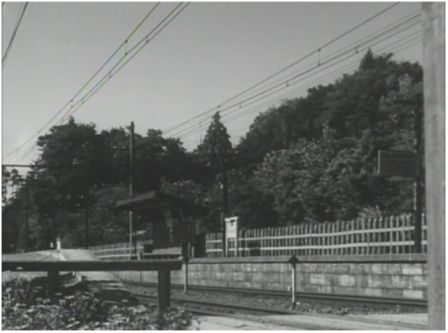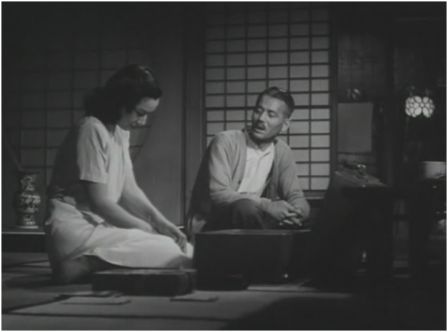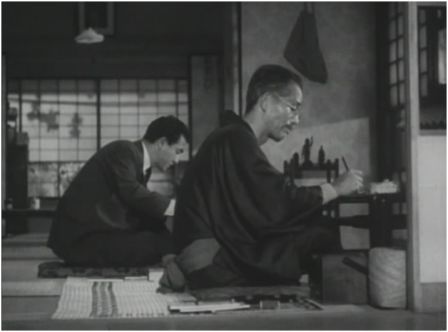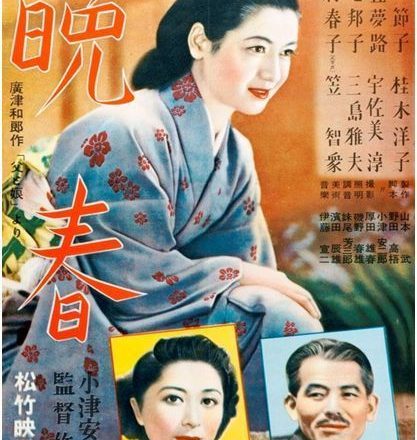Late Spring (晩春)
Director: Yasujirō Ozu
Writer(s): Yasujirō Ozu, Kogo Noda
Country: Japan
Year: 1949
Late Spring (The Criterion Collection) on Amazon.
There are very few directors in the world whose each shot beckons the name of its creator and Ozu is one of them. Every great director has his own subject matter, Kurosawa had his samurai, Tarkovsky his spirituality and Ozu’s is the relationship between family members. This is especially true for this and every other film made onwards.

The film starts in a typical Ozu style with what he calls a pillow shot i.e. a shot or combination of shots in this case that of a railway station and a temple which seemingly is unrelated to the movie at least on a plot level. In his films there is no outer source of conflict; it is always between family members. Late Spring is about the relationship between a father (Shukichi Somiya) and a daughter (Noriko). This is a movie about giving; aunt trying to fix up the marriage, father trying to secure the daughter’s future by marrying her to a decent guy and daughter trying to look after her lonely father. The family members who for the good of each other sacrifice what they want and in return make choices they don’t really want to. Noriko played by Setsuko Hara does a phenomenal job. If ever there was an actress born to play a role then it would be Hara for this role in Late Spring. In a scene where the aunt informs Noriko about his father remarrying look at her hand, the way he plays with a little piece of thread. Notice how such a small detail sums up what Noriko is going through at the moment. There is a scene with a little bit of confrontation towards the end. Notice how Noriko’s head is turned down as if in total surrender to events happening around her. It could also mean to be taken as a sign of respect towards her father, who is everything to her and even if she is unhappy about her marriage she doesn’t want to contradict her father and upset him by going against his words. In this scene there is a sense of restraint in both the characters in truly letting their feelings out. Look at her smile how she is hiding her inner held emotions and constantly trying to repress her feelings that we know are never going to be let out. Maybe it has got to do with the way of the Japanese culture. Ozu is not a loud director; he plays in nuances. Notice how Noriko’s smile at the beginning and towards the end although similar varies vastly in what she is hiding behind it. The characters don’t communicate openly about what they feel; they seem resigned to not get what they want so they go about it quietly in silence.

Ozu has set limitations for himself, low angle, and static camera and from within that he manages to create something profoundly moving. He cuts between axis. Instead of being on a same side of action using 180° rule he cuts from one action to another using the whole available 360° space. He uses constructive editing meaning he doesn’t use establishing shot. He reveals space as the action demands and because he doesn’t follow the 180° rule while cutting, it could be little jarring for the first time viewers to get sense of the space. But it is a part of his style and after watching couple of his films you get use to it. Every single shot is well composed. He uses various rectangular shapes and patterns in his composition like the excessive use of corridors and doors. For conversation he makes actors sit side by side, no over the shoulder shots are used, he rather makes actors face the camera head-on while conversing. He uses cinematic ellipses. For instance Noriko’s groom is never shown in the film which would have been customary to show in other director’s film, he cuts it mercilessly. He provides the detail of how the groom looks like but never shows it, leaving us room for our own conjecture. Several important events happen in between shots which he just skips by.

Ozu has a particular way of filmmaking, he believes in it so much as and to entirely follow those ideals throughout his career. His characters are ordinary, they talk about normal family matters, their lives are ordinary and that’s why the film is universal.
- Decoding time, space and others in Tsai Ming Liang’s the Hole - December 21, 2014
- Late Spring - December 7, 2014
